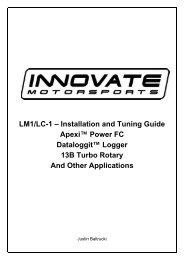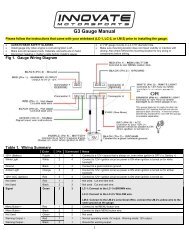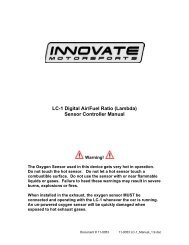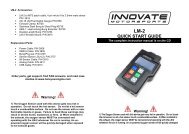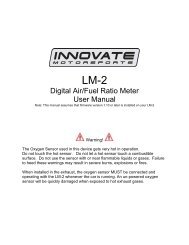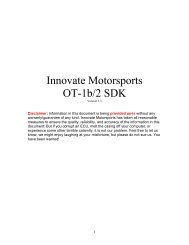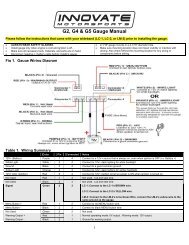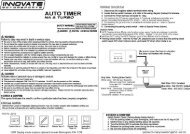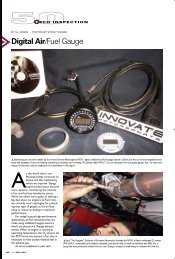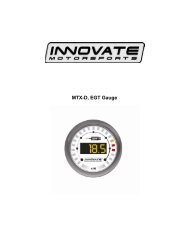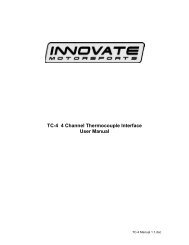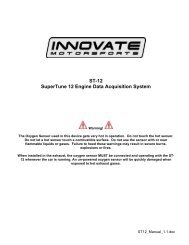"Direct Digital" Wideband Technology Summary - Innovate Motorsports
"Direct Digital" Wideband Technology Summary - Innovate Motorsports
"Direct Digital" Wideband Technology Summary - Innovate Motorsports
Create successful ePaper yourself
Turn your PDF publications into a flip-book with our unique Google optimized e-Paper software.
Application Note 19:<br />
New Fuel Control Strategies Enabled by <strong>Innovate</strong>’s “<strong>Direct</strong> Digital” <strong>Wideband</strong> Controls<br />
<strong>Summary</strong><br />
Oxygen sensors are critical components in every internal combustion vehicle on the road. <strong>Innovate</strong>’s unique<br />
approach (aka “<strong>Direct</strong> Digital”) can be used to control oxygen sensors in a manner that differs greatly from<br />
traditional, mostly analog, technologies.<br />
This, in turn, enables new strategies in fuel controls. While the initial commercial acceptance of the <strong>Innovate</strong><br />
technology has been in the performance aftermarket, the biggest gains will be realized in the OEM market,<br />
where factory-original ECUs can be designed and programmed to utilize <strong>Direct</strong> Digital wideband technology.<br />
Background<br />
Current <strong>Innovate</strong> products use the same wideband zirconiumdioxide<br />
oxygen sensors as current production vehicles, but the<br />
control methodology is completely different. US Patent<br />
#6,978,655, titled “System, Apparatus, and Method for<br />
Measuring an Oxygen Concentration of a Gas,” fully details the<br />
inventions summarized below.<br />
The <strong>Innovate</strong> measurement principle does not use the regular<br />
PID (proportional-integral-derivative) feedback mechanism to<br />
control the wideband sensor. Instead, the pump current is<br />
positive until the reference (Nernst) cell shows < Lambda 1 in the measurement chamber of the wideband. Then<br />
the polarity of the pump current is reversed until the reference cell shows > Lambda 1. This is done with a small<br />
hysteresis. This way the measurement gas in the measurement chamber oscillates at about 100-500 Hz around<br />
stoichiometric. The oscillation frequency depends on the constant (but changing polarity) pump current,<br />
hysteresis, the sensor itself, and Lambda. The frequency has a max at Lambda 1. This is basically a 2-point<br />
regulator, or in digital electronic terms, the operating principle of a delta-sigma analog to digital converter,<br />
except that here the analog value measured is directly the exhaust gas.<br />
The duty cycle PWM of that oscillation is calculated with (t1 - t2) / (t2 + t2), therefore has a range of +/- 1.0. t1 is<br />
the duration of positive polarity of pump current, t2 the duration during negative current polarity. Both measured<br />
with 16 bit accuracy. With PWMair (duty cycle in air) the O2 flow rate of the pump cell can be directly calculated<br />
with PWM / PWMair and therefore Lambda can be calculated from that. Because the sensor is only used with<br />
constant and relative high Ip, but with changing polarity, PWM is completely linear with O2 flow, and<br />
independent of the Lambda/Ip curve of a particular sensor after normalizing to PWMair. Because of the<br />
oscillation, there is no equilibrium state in the cell which would slow down the diffusion. Also because of the<br />
oscillation, there is no electrostatic charge<br />
buildup on the measurement cell that<br />
causes drifts during operation at Lambda<br />
< 1.0.<br />
The Lambda/Ip curve of a wideband<br />
sensor has a singularity at Lambda 1.0.<br />
This causes instabilities in the normal PID<br />
feedback mechanism. The <strong>Innovate</strong><br />
method does not show those instabilities.<br />
A conventional PID feedback loop needs<br />
to be tuned to the speed response of the<br />
controlled system. The best one can do is<br />
to achieve critical damping, otherwise it<br />
would lead to wild oscillations and over<br />
swings. The <strong>Innovate</strong> principle approach<br />
basically makes specific use of those by<br />
running the feedback loop deep into those<br />
normally undesired oscillations.
In a conventional PID feedback wideband controller the temperature is regulated via the AC impedance of the<br />
reference cell (usually measured with a small AC current of 1-4 kHz). This measurement frequency has to be<br />
filtered back out of the reference cell signal with low pass filters and that cause further latency in the<br />
measurement loop.<br />
The <strong>Innovate</strong> system uses the AC impedance of the pump cell, which shows the same temperature behavior as<br />
the reference cell. With the <strong>Innovate</strong> measurement principle already essentially impresses an AC current on the<br />
pump cell, it’s possible to measure its temperature for temperature regulation without any further hardware<br />
costs.<br />
A further slowdown of the conventional PID measurement loop of a wideband comes because many wideband<br />
controllers drive the pump cell with a low impedance voltage source (op-amp output) directly. The pump current<br />
is then measured with a measurement resistor. But the pump cell in a wideband acts also like a Nernst cell that<br />
produces a counter EMF that’s dependent on the Lambda value in the measurement chamber. This counter<br />
EMF is essentially shorted by the low impedance source and then causes a reduction of the pump current<br />
during Lambda transitions, which is in turn compensated by the changing error value in the reference cell. This<br />
means, in a regular PID implementation of the measurement loop of a conventional wideband controller, many<br />
(often hundreds) loop passes are made through the delay between pump cell and reference cell. With the<br />
<strong>Innovate</strong> “2-point regulator” implementation only two passes are needed for a complete Lambda measurement<br />
as Lambda can be calculated after every oscillation period. This is the major reason the <strong>Innovate</strong><br />
measurement principle is so fast.<br />
Response Time<br />
The fast response time of <strong>Direct</strong> Digital technology enables new fuel control strategies. The biggest impact is in<br />
two areas:<br />
1) Rapid load-transition Periods. Due to the slow response time of PID systems, even the most<br />
sophisticated modern vehicles must go “open-loop” for up to 500ms second after major throttle<br />
transitions (for example, “Acceleration Enrichment” period). Such open-loop operation often results in<br />
excessive fuel injection (and therefore reduced MPG, and increased emissions) during transitions. In<br />
most regular driving, transitions are quite frequent. It is estimated that eliminating open-loop<br />
operation acceleration enrichment improves average fuel economy by as much as 7%, and reduces<br />
emissions by the same amount.<br />
2) Injector balancing. OEMs allow up to 5% cylinder-to-cylinder variation in new fuel injectors. This is<br />
less than ideal to begin with, as some cylinders will be lean (producing excessive NOx), and some will<br />
be rich (producing excessive CO). The real problem however, is that this condition deteriorates over<br />
time (injector clogging, etc.). Cylinder-to-cylinder variation climbs to 10% or more, stressing the<br />
catalytic converter, damaging engines, and producing excess emissions. <strong>Direct</strong> Digital technology is<br />
fast enough to enable a single sensor to detect individual-cylinder lambda as the “slugs” of exhaust<br />
pass the sensor. This allows the ECU to vary each injector’s duty cycle, and precisely manage each<br />
cylinder.<br />
The benefits of full-time closed-loop operation are clear- essentially you have a self-tuning, adaptive engine<br />
that can handle major variations in fuel composition, barometric pressure, and component aging. However,<br />
until <strong>Direct</strong> Digital, many of the gains from closed-loop operation were unattainable.<br />
Full-time closed loop functioning does not preclude the ECU from building and maintaining a safe “fallback”<br />
fuel map. If an oxygen sensor fails during normal operation, the ECU will then be merely as smart as the<br />
best current ECU.<br />
Conclusion<br />
Designers of new fuel-control systems should fully explore the benefits of implementing full-time, closedloop<br />
injection strategies based on <strong>Direct</strong> Digital <strong>Wideband</strong> systems.




